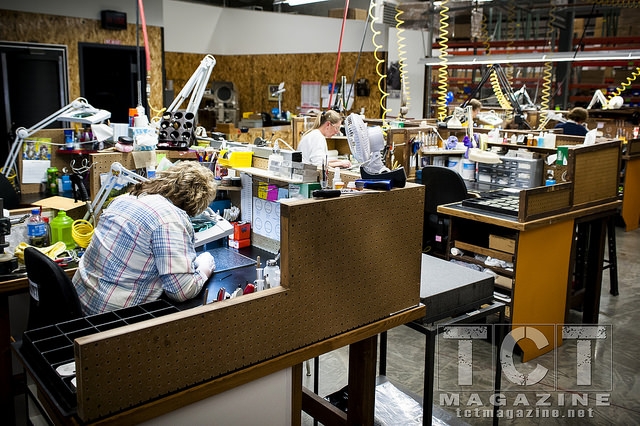Fast-forward to 2015 and D.W. Brunton’s legendary Pocket Transit continues to be relied upon by geologists, engineers, and the United States Military; often holding a special place in the hearts of those who rely upon it for day to day navigation and mapping. While the materials and manufacturing technology continue to improve and functions are added, the overall design remains the same as those early units. Each Pocket Transit is made, by hand, in the small town of Riverton, Wyoming and that is where I was able to meet the talented men and women whose job it is to continue the tradition of designing and building this legendary equipment.
I have spent a lot of time working in, and building, large manufacturing facilities. The hiss of steam lines venting and the clanking of equipment often feels orchestrated, as if the production lines are conducting a concert. This was not the case at Brunton; the quiet, almost Zen-like, sound of the employees assembling Pocket Transits and compasses was faint. The building was not void of sound, the machine shop was cranking out components and the sonic welder was humming, but it felt like the production area was more focused. At times I was afraid the sound of my camera shutter might disrupt their focus.
Today’s Pocket Transits contain a myriad of small components, all interlocked to provide accurate navigation and measurement. Each unit is carefully checked, after each component is installed, to ensure proper function. A unit is not given the greenlight to move onto the next step until it meets these quality requirements. Bodies and components that do not make the grade are recycled to prevent poor-quality components from making it into the field.
Modern transit bodies are available in both aluminum and composite, depending on the model, with the aluminum bodies cast at a foundry in Colorado and the composite bodies molded in Wyoming. Keeping the entire manufacturing processes state-side allows Brunton maintain its commitment to quality and ensure their products meet the daily rigors of the end user. While many companies are looking to send production overseas, Brunton now assembles all of its navigation products at their Riverton facility.
Related Articles
The employees demonstrate a real sense of pride in their work and the equipment they manufacture. They understand the Pocket Transit once revolutionized how the world was explored and mapped. I believe that, by continuing their tradition of innovative design, Brunton has secured the Pocket Transit as a valuable tool for generations to come.
[flickr set=72157656709272246]
To get your copy of the
July 2015 issue:
FIND US ON:








